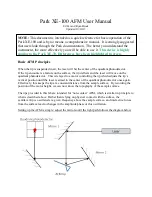
27
Total magnification
Total magnification = objective magnification x
eyepiece magnification.
If using the magnification changer (
→
p. 48),
multiply the set magnification factor, e. g. 1.5x,
as well.
Useful magnification
The total magnification of a light microscope is
subject to physical limits known as the useful
magnification. This is roughly
a thousand times
the aperture of the objective.
Examples:
If the tube factor (TF) is other than 1x, the result
must be divided by the tube factor as well.
In the above example, the object field would be
0.5 : 1.5 = 0.33 mm with TF = 1.5.
Simple survey magnification
Use a 4x, 5x or 10x objective. Hold specimen over
the light exit in the microscope base instead of
putting it on the stage. If the 2.5x lens (con-
denser disc) is in the light path, disengage it.
Caution!
Do not cause any scratches!
Objective
Eyepiece
Magnification
Total
Upper limit
Comment
changer
magnification
of useful
magnification
10x/0.22
10x/20
–
100x
220x
not exceeded
10x/0.22
10x/20
2x
200x
220x
not exceeded
40x/0.60
10x/20
–
400x
600x
not exceeded
40x/0.60
10x/20
1.5x
600x
600x
not exceeded
40x/0.60
10x/20
2x
800x
600x
exceeded
In the last example, therefore, the “Useful
Magnification” has been exceeded, which may
result in blurred images.
Object field diameter
If you divide the eyepiece field of view number
by the objective magnification, you obtain the
true diameter of the observed object field. The
eyepiece magnification is not taken into account
in the calculation. With the 10x/25 eyepiece and
a 50x objective, for example, an object field of
25 : 50 = 0.5 mm can be surveyed.
Focus by adjusting the height of the stage (23.5)
or the condenser (23.3).
Although this method does not claim to produce
a good image, it offers the advantage of great
field depth, e. g. for fast scanning of series of
specimens in a similar way to a magnifying
glass. If the photomicrographic equipment does
not comprise a data reflection facility, a labelled
piece of foil or paper can be copied onto the
beginning of the film, for example, to enable
identification in the photo lab.
!
Summary of Contents for DMLS
Page 1: ...M I C R O S Y S T E M S Leica DMLS Instructions Bedienungsanleitung Mode d emploi ...
Page 3: ...3 M I C R O S Y S T E M S Leica DMLS Instructions ...
Page 54: ...54 ...
Page 55: ...3 M I C R O S Y S T E M S Leica DMLS Bedienungsanleitung ...
Page 106: ...54 ...
Page 107: ...3 Leica DMLS Mode d emploi M I C R O S Y S T E M S ...
Page 158: ...54 ...
Page 159: ......












































